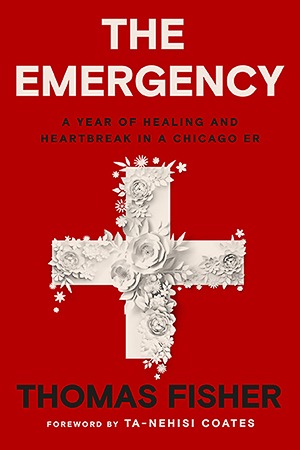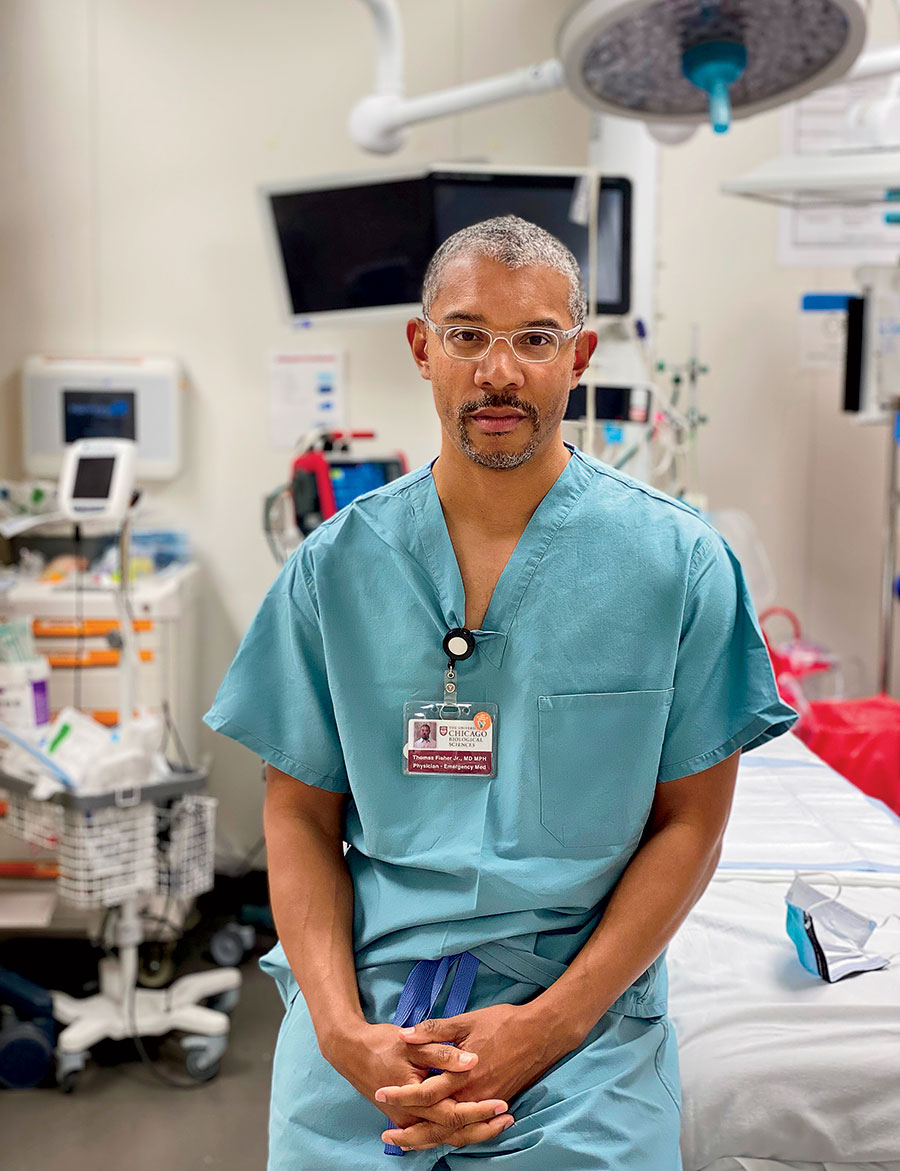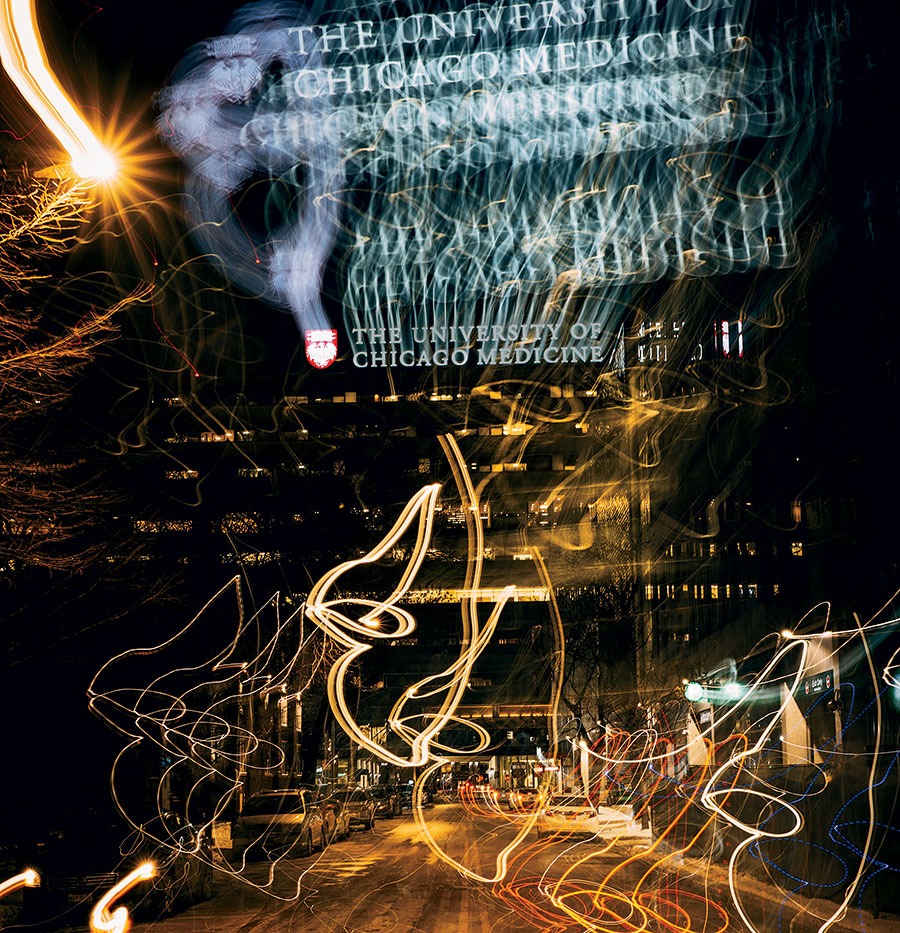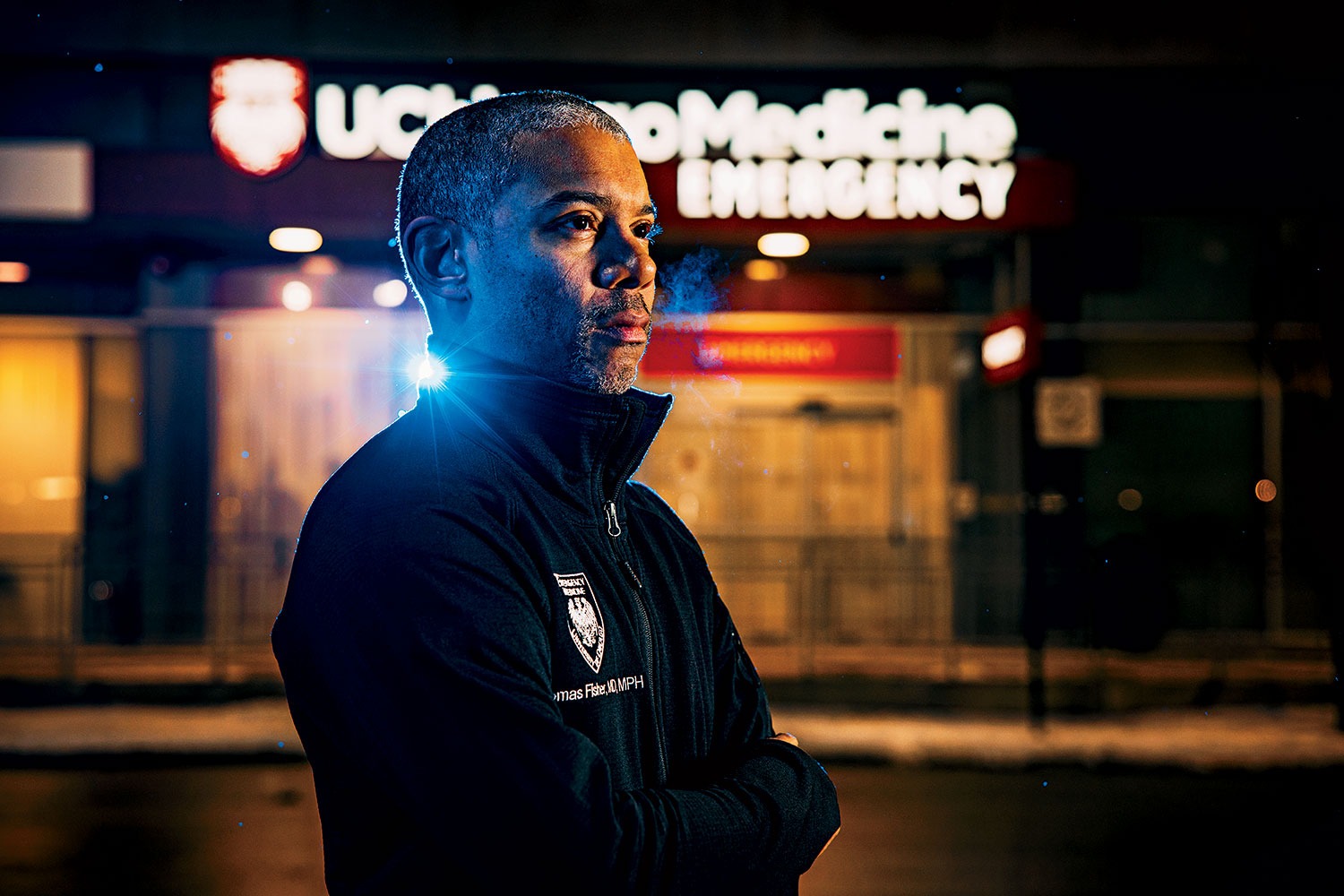Thomas Fisher doesn’t hold back in his new book, The Emergency: A Year of Healing and Heartbreak in a Chicago ER. The University of Chicago Medicine doctor portrays a deeply flawed health care system strained by a deadly pandemic and searing injustice. In this excerpt, which takes place in May 2020, the 47-year-old Hyde Park native recounts how medical personnel and patients at his South Side hospital’s emergency department dealt with a time unlike any other. The people who appear in this passage are composites of real individuals and cases, with names and identifying details changed. For storytelling purposes, Fisher has collapsed several ER shifts into one.
Last night I heard screams in my dream. I was walking across a pasture toward a picnic where my family was eating. The meadow was not in Chicago but out of a storybook. Green grass to the horizon, spotted with white flowers. A shining sun, beaming but not hot. I could see my parents and sisters on the red checkerboard blanket, laughing and having a great time. I was on my way, excited to join, but every few steps I heard the screams. Every time, a woman’s terrified yell stopped me in my tracks. It came softly from behind me, loudly from above, with distortion from the left. I’d look to see where it originated, but there was nothing around but green grass and my oblivious family across the field. Over and over I’d resume walking until I was again halted by the scream. I never made it to the picnic.

Over coffee this morning I realize that the scream was from the emergency department. Two nights ago, I was caring for a car accident victim when they rolled in a 23-year-old woman wearing a blood-spattered yellow tracksuit with gauze covering her face and arms. She had been in a car that was sieved by bullets. One side of her face was made up with lipstick and those false lashes that look like a daddy longlegs, the other side was mashed to currant jelly. Both hands and arms had been shot as well. She must have seen her assailant coming, put up her hands, and caught slugs. Her incoherent mumbling ended when they moved the gauze that covered where her left eye should have been. Her scream filled the room, loud enough to be heard over the monitor alarms and physician orders. That was the scream from my dream.
Nowadays my sleep is rarely peaceful. Violence is rampant even as COVID has emptied the streets, closed restaurants, and canceled travel. Social distancing has reshaped Chicago and my life. When I’m not in the ED, I text and Zoom with friends, write, exercise, and take walks with my sister and niece to manage loneliness and fear. Yesterday was a stunning, 70-degree spring day. I walked past the ball fields and public pool at Eckhart Park and checked out the huge, refurbished playground. With two kinds of swings and a climbing gym, it’s a kids’ nirvana. Surrounded by a field of dandelions and trees that were starting to bear leaves, it was chained closed. Not a single kid: no laughing, no chasing. It was empty. I spent half that day walking until I couldn’t hear the scream anymore, but it returned in my dream anyway.
The bucket boy is back. He’s at the Garfield Boulevard off-ramp, drumming solos with his mask under his chin. I pull up to the light listening to a dance track whose few decipherable words include the phrase “I am now and now is me.” He seems to hear my music and syncs up with the beat. He deserves more than the couple bucks I offer him. Two months ago, I accepted that I’ll probably be infected, but now I feel defiant. I will not capitulate. This is what I trained for, and I intend to execute for as long as I can.
Two nights ago, I was caring for a car accident victim when they rolled in a 23-year-old woman wearing a blood-spattered yellow tracksuit with gauze covering her face and arms. She had been in a car that was sieved by bullets. Her incoherent mumbling ended when they moved the gauze that covered where her left eye should have been.
As I near the hospital, I see that Washington Park is still abandoned. A few older Black men walk toward the corner of Michigan Avenue and Garfield Boulevard. The man with an amputated leg who pushes himself around in a wheelchair is gone, as is his diminutive friend who sells socks down the street. I wonder what has happened to them.
I’m taking over this shift from Laird. A generation older than me, he was one of the doctors who taught me emergency medicine. After changing into hospital scrubs, a disposable mask, head cover, and eye protection, I greet him to take over his patients. In-person human contact is the best part of my shifts, so I’m excited to talk with him. Laird confides that his new COVID routines threw him for a loop today. “Sheesh,” he says. “I have to tell you, I’m glad you’re here. I’ve had a bizarre day.”
“Tough one?”
“Getting out of the house is so complicated now. I misread my shift time and arrived an hour and a half late.” He’s masked up, in hospital scrubs and dress shoes, and seems overjoyed to just vent.
Two months into the pandemic, the initial convulsion has given way to new patterns. Laird and I speak across a desk rather than side by side. Our facial expressions hidden by masks, we try to discern everything we can from tone of voice, from eyes. Laughs are louder now, hand gestures more definitive. Every other desk monitor is turned off and blocked by a sign indicating the space is not in use to meet physical distancing requirements. Before we begin signing out patients, I embark on an elaborate sequence of disinfecting my chair, keyboard, and mouse. This may or may not make any difference, but the choreographed ritual is reassuring and signals to others that I’m serious. As I clean, Laird dances back and forth while he speaks, moving away from me when he realizes he’s too close and then moving back when he’s gotten so far away that I strain to hear him over the din of the ER.
One of the patients he transitions to my care is a 32-year-old woman.
“The young woman in Bed 18 came in by ambulance. She was having a normal day, then all of a sudden she fell to the ground and couldn’t get up.”
I stop cleaning to hear this. “What?”
“Yeah, she’s young. On arrival she couldn’t move her left side, not even grasp with her left hand. It recovered a little but not much. Anyway, she’s getting directed thrombolytics right now.” He pauses thoughtfully. “Have you seen anything like this?”
“Umm, no, never.” I’m listening closely. Young people who suffer devastating strokes are very rare.
“A couple hours later, her test came back positive for COVID. This is the first stroke I’ve seen associated with the virus.”
I just shake my head. What is there to say? She was infected, and her first and only symptom was the stroke. Until she returns from the radiology suite where she is being treated, we won’t know how she’s doing. None of us have seen anything like this. The coronavirus is making us relearn medicine.
Social distancing orders and fear of COVID have kept people away from the emergency department. Our patient volume has fallen by half. Now the waiting room is empty. Patients who would’ve waited hours or more for a bed now go upstairs within minutes. Consultants who dragged their feet before seeing our patients are suddenly prompt. After the initial COVID surge, fewer colleagues have fallen ill with coronavirus, and the looks of fear and the hushed tones are gone. ER conversations have moved from what we’re doing to stay safe to how we’re staying sane while shut in at home. Previously I turned off my emotions as best I could and pushed through shifts, trying to return to normal life outside the hospital as quickly as possible. Now there is no normal life outside, so I linger in the comfort of the ER’s familiar pace and people. A few days earlier, a beloved peer, in her goldfish-ornamented hair cover and matching yellow goggles, noted how the hospital’s COVID focus has created ER efficiency.
“Look at these wait times. It’s like a normal emergency department!”
“Right? This must be what it’s like to work in a community hospital with an efficient ER,” I replied. “We need things to go this way from now on. But if they did, we’d never make any money.”
“OK, but are we in the business of making money or the practice of saving lives?” We both laughed loudly and got back to work.

My first patient is a 54-year-old man still groggy from a heroin overdose. He was found unresponsive in a car where he had snorted a dime bag with his friend. When he would not wake up, his companion called 911. Paramedics arrived and injected him with naloxone, and he came around. He sports a crisp haircut, which is unusual in these times of social distance, and his heavy eyelids pause with each blink. I stand in the room, masked, along with a masked resident who’s leading the conversation into the circumstances of his illness. After a couple of minutes, she asks, “Did you use drugs?” He pauses and after a side-eye responds that he snorted heroin. I jump in. “When was the last time you used before today?”
He’s now defensive. “Why?”
“Usually, people who use every day don’t get knocked out, so you must not use often.” I soften my tone, hoping he’ll open up. His body visibly untenses.
“Oh yeah, you’re right. The last time was five months ago.”
Five months sounds like a bid. I ask if he had been locked up, and he confirms.
“Welcome home, fam.”
He grins and thanks me. Then he explains that he was released early only because of COVID.
The resident and I sit down and debrief. Narcotic overdoses have become common again. The proliferation of fentanyl boosts street heroin’s potency, and COVID has led to early release for people who have lost their tolerance. We regularly care for older folks who have used heroin for years but are now overdosing. This patient’s care is easy — we just observe him to make sure he continues to recover — but we can’t forget to counsel him, or to send him home with a prescription for naloxone so someone can save him if this happens again and the paramedics are too far away.
I stroll to Room 10 to meet a 29-year-old man with a headache. It’s unusual for an Asian man to come to our ED, so right away I assume he’s affiliated with the university. He’s sitting in a chair with the lights off, holding his head. Code-switching to a collegial tone, I say, “Hello, sir. I’m Dr. Fisher.” He responds in kind: “I’m Andrew. Nice to meet you.” He sits up straight, makes direct eye contact. We exchange elbow bumps.
“I understand you’re having a headache? Tell me about it.”
“Well, it’s a long story, but last night I was on call and began to experience occipital throbbing. I thought I might be sleep deprived, but after resting today I awoke with worsening pain in the same location. I felt it’s best to come in.” He’s poised and direct and provides descriptions in the same order that we use when writing our medical histories. I probe further.
“You were on call?”
It turns out he’s a third-year resident doctor in internal medicine. Ten years ago, while an undergrad in Boston, he had brain surgery to fix an aneurysm. For him, headaches aren’t simple. I approach health discussions with medical professionals differently: more specific questions and more medical terms.
“Do you have diplopia?”
“No.”
“Photophobia?”
“No, but I had a scotoma in my right visual field when it started, and now my left arm is heavy.”
While this could be a migraine, I’d hate to miss another aneurysm, and so we engage a neurologist and order a CT scan of Andrew’s brain. We discuss his treatment and diagnostic plan. He works here too, so he understands that he’ll be here all day.
I return to my computer, and I notice our rotating intern has stepped away to eat. Twenty years ago, when I was an intern, there was no such thing as “away eating.” We didn’t eat on shift unless we brought food and wolfed it down while hiding in the telemetry radio room. Andrew, my headache patient, let me know that he got four hours of sleep on ICU call. When I was on call in the intensive care unit as a resident, I rarely saw the bunk beds in the call room and only went to those private quarters to brush my teeth before rounds in the morning. We spent all night on our feet, remaining at the hospital from 6 in the morning until 6 p.m. the next day — 36 hours. We did this every third night. Four uninterrupted hours of sleep was unheard of.
Back then, lip service was given to self-care. It generally went no further than drinking water and using the bathroom so that we could get back to work. I trained in abusive and inhumane times, when residency was as much a test of resilience and endurance as clinical training. Work-hour restrictions were haphazardly implemented halfway through my residency. A couple of my peers got divorced during residency, and we all had varying levels of depression and resignation. I jest with the residents, telling them how hard it used to be back in my day. It’s in fun, but I’m still scarred by the wounds residency inflicted on me.
Right on cue, my resident Theresa complains about being house staff. The electronic medical record keeping takes so much of her shift that she never gets to spend time with her patients. She works so much that she can’t see her wife. The painful start to a career that will be marked by sacrifice. This is not the time to compare suffering, so we discuss how to manage this: coping, remaining present, and balance. I want to reveal it all, the lifetime of struggle ahead of her, but there’s a patient to see.
This skater named Morris hit his head when he fell on a half-pipe yesterday. Morris is a tall man, 24 years old, with fuzzy cornrows under a patterned cap, wearing a matching T-shirt and shorts. He is slumped in the reclining chair with his hand in his shorts and a COVID mask below his nose. I introduce myself and ask him to raise his mask over his nose. Morris barely makes eye contact, shifts his mask with one hand while the other remains in his shorts.
A sharp tone frames his words: “Can I get a room with a bed? My head hurts.”
When patients confront bureaucratic waits, unexpected treatment paths, unsympathetic registration, and inefficient care, they’re incensed. Anger is common. Yelling is common. Even violence — I’ve seen doctors punched in the face.
He’s annoyed — angry about the wait, the chair, the fall, and the mask. All reasonable. While he wasn’t knocked out and doesn’t have signs of bleeding, he’s probably got a concussion but is otherwise fine. He’s not reassured by our conversation, so I offer him a head CT to be sure. He doesn’t know if he wants it.
“I waited for hours, now it’s on me to decide?”
“No worries, bruh,” I tell him, “it’s not on you. Let me get you some Tylenol, and let’s do the scan.” He agrees but his fist remains tightly curled.
I’m in the ED all the time, but for my patients their visit is a special day. Most people rarely come to the ED, and when they do, it’s with an expectation that their sense of emergency will be precisely matched by the hospital staff — it’s what they’ve seen in a hundred movies and television shows. When they confront bureaucratic waits, unexpected treatment paths, unsympathetic registration, and inefficient care, they’re incensed. Anger is common. Yelling is common. Even violence — I’ve seen doctors punched in the face.
People with power and agency call their doctor or their influential friends to pull whatever strings they can to ensure they never face these rusty gears. Everyone else suffers longer than they should and is ignored when they demand more. I can neither fix the system in the middle of a shift nor work around the obstacles for every person every time. After being forced by rules or resource limitations to deny patients simple graces like pillows or a visitor, I used to avoid returning to their rooms out of shame. I’d close the door and try to forget. No matter what I said, they interpreted my inability to deliver as mistreatment. And while my avoidance protected me from feeling like a failure, it added to their perception of institutional neglect. They’re right. Their anger and sadness are justified, and their assessment of my role is accurate. I am a perpetuator of the system’s mistreatment, and I am also a casualty, trying to do the best I can with what I have.

A woman in Room 19 is here because she cannot urinate. She’s 51, in a cloth mask, a head wrap, and clear lunch-lady gloves. Sitting in the chair farthest from the door and away from the bed, she makes eye contact with me.
“Hello, Ms. Franklin, what’s wrong?”
She begins a long, meandering story about her regional pain syndrome that she refers to with an acronym, CRPS, that I’ve never heard before. She tells me about her nerve stimulation implants for pain, a hip replacement, and kidney stones. Her lupus caused blood clots in her legs and lungs. I think about how I feel when I’m rushing to find a bathroom and compare it to her comfortable countenance and winding story. If she’s not stressed, I’m not stressed, so I sit on the bed next to her unused gown and listen. Finally she gets to why she’s here.
“I can’t urinate, it comes only in dribbles.”
“Ah, got it. No problem. Let’s put in a catheter to relieve the pressure.”
She’s happy with the plan, tells me she’s had catheters many times, including catheterizing herself while at home. She looks at the gown I was sitting next to and asks, “Can I get a new gown? You’ve been in all those COVID rooms and touched it.”
Not a problem. These are stressful times — let’s do the easy things if we can.
In Room 14 is a young man swollen head to toe, but worst around his eyes and his hands and legs. Robert has had this problem in the past and knows that it’s caused by a type of kidney failure. Twenty-five is young for kidney failure. He has curly hair, a red T-shirt decorated with the likeness of President Obama, and blue sweats that have a yellow left knee and red right knee. When I come in the room, Robert has his mask hanging from one ear, and he’s on the phone talking. Before I even introduce myself, he asks, “Can you talk to my mom?”
“Sure, put her on speaker.”
His mom’s raspy smoker’s voice fills the room. “How are you, Doctor?”
“I’m good, ma’am, happy to meet you.” She explains that he was here yesterday for the same problem but went home because it was his birthday and he did not want to spend it in the hospital. The three of us discuss a plan to admit him, get him medications to reduce his swelling, and treat the kidney issue that’s causing it. She thanks me and tells her son she loves him. I ask him if he has any questions.
“Nah, we good.”
I notice his right leg is more swollen than his left, something we see with blood clots. I ask, “Is that always more swollen?”
He says, “Yeah, ever since I was shot a couple years ago. Can I get a bed? This chair is uncomfortable. Maybe some food?”
I agree, but I warn him that even when we’re not too busy it can take a heroic effort to get patients food. I have to unravel an administrative snarl.
The gentleman who overdosed is now awake and ready to go home. He needs bus fare. I start a walk around the ED to find Frankie, the social worker. The walk is gratifying, and I stop to make eye contact and chat with every colleague I can. After weeks of social distancing, I’ve become awkward in conversations. I feel like a puppy begging to be petted. My colleagues who are parents share their struggles with childcare and homeschooling. Others mention their longing for a pint in a bar or a plate of pasta in a restaurant. They wonder when, if ever, they’ll feel comfortable doing that again. One lets me know that he won’t set foot in a gym for a long time. We’re all mourning the loss of our pre-COVID lives. I locate Frankie, and she unearths a bus card for the gentleman. On my way back to my desk, I find Morris’s room empty. His nurse says he didn’t wait for the CT — he just rolled out, muttering and angry.
From my seat, I see paramedics carrying in a man with blood streaming from his right leg. I jog over to accompany them to his room. His black jeans are wet with blood, which has pooled on the paramedics’ gurney, and they’ve cut open his pants to expose his leg. He has wounds on both sides of his calf. I walk with them into Treatment Bay 8, and an internal medicine resident joins us. The paramedics coordinate to move the man “on the count of three” from the gurney to a chair, as there’s no bed available. We help him take off his blood-soaked Air Max shoes and tattered black jeans. He’s neither wincing nor angry. He’s stoically quiet. We’re the same age.
“What happened, sir?” I ask.
“I was standing outside a store, shots were fired. I really don’t know what happened.”
He has a normal pulse in the leg, the bones seem stable, and he can move the leg normally. The resident and I decide to do an X-ray, test for a vascular injury, get him pain medication, and send a couple labs. When the resident goes to a computer to enter the labs, I take another look at the leg. It seems like the bullet went right through the muscle without damaging vessels, nerves, tendons, or ligaments. He was lucky.

The previously dead ER starts to pick up. Another pair of paramedics rush past with a full stretcher. I leave Bay 8 and follow right behind them into Room 12.
“Doc, another OD.” I meet a groggy 37-year-old man in sunglasses, jeans, and a White Sox jersey. The paramedics tell me that he was passed out on a bench before they gave him Narcan.
“Do you know where you are?”
“UIC.” By this he means the University of Illinois Chicago, eight miles north.
“Nope,” I say. “U. of C. You’re on the South Side.”
“Oh, good!” he cries, perking up and clearing his throat. I can see the crust in the corner of his eyes, hear the secretions pooled in his throat. I flinch inwardly and back toward the door as he gurgles.
“Fam, put your mask on. Have you had a COVID test?”
He refuses to answer. “I know I’m negative,” he says.
Of course he doesn’t know, and he doesn’t want to know for rational reasons that are still wrong. I’ve seen so many patients who say that same thing: If he’s positive, he becomes a pariah and gets shunned. We do for him what we’ve done for all the other heroin overdoses. We watch him.
Back at my computer area I notice two colleagues chatting.
One is wearing a half-face respirator. It filters 100 percent of three-micron particles and securely covers his face from the nose down, with pink filters on either side and a blue facepiece in the middle. His voice is muffled. He has on protective eye covers, and his grayed and balding pate is visible above. He’s relaxed and confident. The other has a blue surgical mask and blue nitrile gloves. His mask hangs below his chin, exposing his face. He’s pecking at the keyboard with one gloved hand and eating an apple with the other. One looks ready for a pandemic; the other is playing safety charade. I don’t judge. We all have lapses. Even if the lapses can be costly.
Weeks ago, every patient had symptoms, but now only about a third are sick with the virus. We test everyone who will let us and counsel the rest. Our reflexes have become attuned to sneezes and coughs. It feels sometimes like the virus isn’t just inside our patients but is restless, clamoring to escape and infect us. We hold it at bay with masks and distance, but after weeks and weeks of this, we’re tired and starting to let our guard down. Staff members now leave their masks behind for extended periods, sipping drinks at their desks, laughing with arms around each other. Earlier in the pandemic I’d find free food in the ER every day, donated by restaurants or celebrities and labeled “To Our Heroes.” That’s over, and we are back to scrounging cabinets for Rice Krispies treats. This new phase with fewer COVID cases is a welcome respite. Folks are tired. But we all know it won’t last.
My last patient is a very stylish 79-year-old woman. She’s in a silver jacket, silver Nikes, gray jeans, and a gray shirt.
Her curly salt-and-pepper Afro frames her face like a halo. She’s crying. She came to have a bullet removed. In March a stray bullet flew through her car window, broke her glasses, and lodged above her right eye. She was supposed to travel to Ghana the next day and couldn’t go — but she didn’t miss much because her friends had to return early due to COVID restrictions anyway. Now it’s May, and she’s tired of having this bullet in her face. I examine her, but I don’t see any scar or swelling. The wound healed, but her head hurts, and she says she can feel the bullet moving in her sinus when she shifts position. It’s been scheduled for removal multiple times, but every time the surgery has been canceled by COVID. She can’t take it anymore.
“I want it out, and I want it out today.”
“The computer says the surgery is scheduled for June,” I tell her.
“I can’t wait that long. It’s driving me crazy!” She’s very upset. It’s not just the physical suffering but the continued imposition of this shooting on her life. A violent interruption. One moment she was driving, minding her own business, and in the next a bullet changed everything. People come in all the time to have bullets removed. In this case removal wouldn’t just stop the pain but close this chapter in her life. I know we can’t get it out today. But I can listen. I nod my head as she talks and hold her hand.
I change clothes and prepare to head home. Today I feel the usual fatigue and angst from a busy shift but also a quickening inside me at the prospect of this break for freedom at the end of the day. On an almost empty expressway I’m giddy as I push the speed and turn up the volume. I’m running from the ER. But the ER runs just as fast. It catches me, even on the expressway, and squeezes my mind in its grip. Is there something I missed? Did I forget something? Did I finish everything? The throbbing bass competes with nagging doubts for my attention. I touch the accelerator again and speed off. I’m done. I survived, and so did my patients. Dance music thumps and the streetlights strobe past. I push all memories of the day out of my mind. I’m floating, but I know this feeling won’t last. Something is waiting for me in my dreams.



